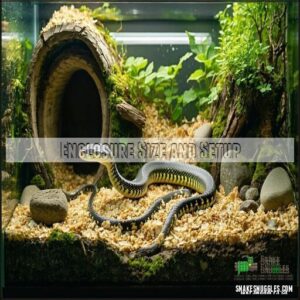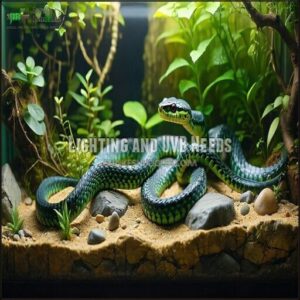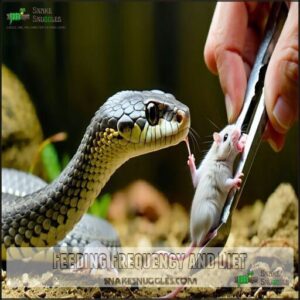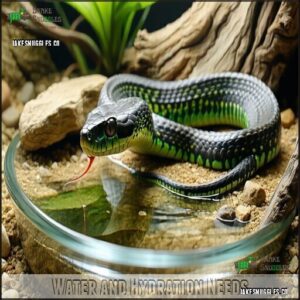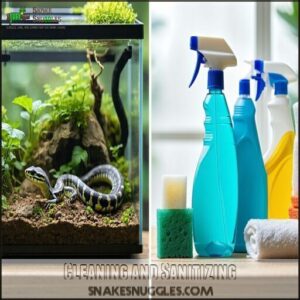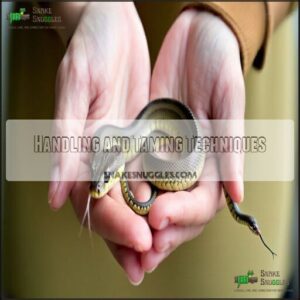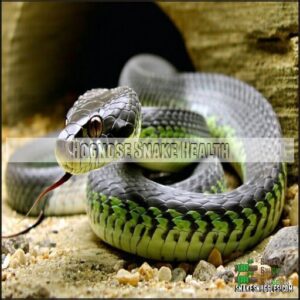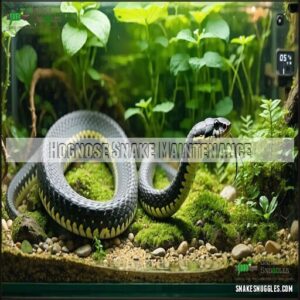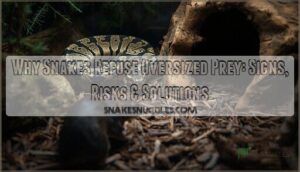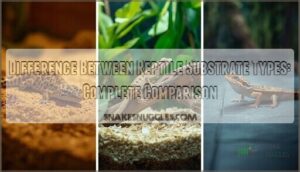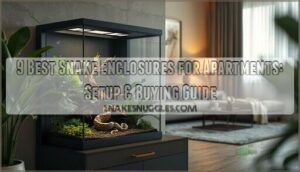This site is supported by our readers. We may earn a commission, at no cost to you, if you purchase through links.

Provide 3-4 inches of substrate for burrowing—these little diggers love to disappear! Maintain 30-50% humidity and feed thawed mice sized appropriately for your snake’s body width.
Hognoses are drama queens of the reptile world—they might hiss and play dead when startled, but don’t worry, it’s just an act. They have unique defensive behaviors that can be surprising.
Clean their habitat weekly and handle them gently to build trust. Understanding their behavior will help you form a stronger bond with your scaly friend.
Table Of Contents
- Key Takeaways
- Hognose Snake Habitat
- Hognose Snake Care
- Hognose Snake Health
- Hognose Snake Behavior
- Hognose Snake Maintenance
- Frequently Asked Questions (FAQs)
- Do hognose snakes need a care sheet?
- Do western hognose snakes need a large enclosure?
- What should I know about hognose snakes?
- How should you feed a hognose snake?
- Which hognose snake should I buy?
- How often should a hognose snake be handled?
- Are hognose snakes easy to take care of?
- What size tank do hognose snakes need?
- What do hognose snakes need in their cage?
- Do hognose snakes like to be held?
- Conclusion
Key Takeaways
- You’ll need to maintain a proper temperature gradient (90-95°F warm side, 70-75°F cool side) and 30-50% humidity in your hognose snake’s enclosure to keep them healthy.
- Provide at least 3-4 inches of substrate like aspen shavings or coconut fiber to satisfy your snake’s natural burrowing instincts.
- Feed your adult hognose once weekly with appropriately sized thawed mice (matching their body width), while juveniles need feeding every 4-5 days.
- Don’t be alarmed by your hognose’s dramatic defensive displays like hissing, hooding, or playing dead—with consistent, gentle handling sessions of 10-15 minutes 1-2 times weekly, you’ll build trust with your hognose snake.
Hognose Snake Habitat
Creating the perfect habitat for your hognose snake guarantees they stay happy, healthy, and stress-free.
From choosing the right enclosure size to maintaining ideal temperatures and humidity, every detail matters to keep your snake thriving.
Enclosure Size and Setup
Creating the perfect hognose snake enclosure takes balance and care. A good snake enclosure starts with proper sizing.
Follow these tips:
- Hatchlings thrive in smaller terrariums (2ft long).
- Adults need vivariums around 90x45x45cm.
- Always include secure lids and deep substrates for burrowing.
Maintaining proper ventilation is key for a healthy habitat, so ensure proper airflow.
Add enrichment items like rocks or branches. Offer plenty of hiding spots for comfort.
Temperature and Humidity Requirements
Your hognose snake relies on a temperature gradient for health.
Keep basking at 90-95°F (32-35°C) and the cool side at 70-75°F (21-24°C).
Maintain humidity at 30-50% using Heating Methods like lamps and humid hides.
Hognose snakes are diurnal, so providing appropriate UVB lighting is also beneficial.
Monitoring Tools guarantee accuracy.
Adapt seasonally to keep conditions just right.
| Factor | Ideal Range | Tools Needed | Example Devices | Notes |
|---|---|---|---|---|
| Basking Temp | 90-95°F (32-35°C) | Heat lamp, thermostat | Infrared thermometer | Prevent overheating. |
| Cool Side Temp | 70-75°F (21-24°C) | Digital thermometer | Thermostat combo | Check daily. |
| Humidity | 30-50% | Probe hygrometer | Hygrometer gauge | Adjust as needed. |
| Heating Methods | Heat lamp, mat | Dimming thermostat | Arcadia Deep Heater | Never skip guards. |
| Seasonal Adjustments | Slight changes OK | Ambient room heater/cooler | Temperature controller | Changes subtly. |
Lighting and UVB Needs
Lighting plays a key role in snake care.
Use UVB benefits to support your hognose snake’s health and activity. Opt for a T5 6% bulb, covering half the full-spectrum enclosure.
Keep basking distance 6-9 inches with mesh. Maintain 12-14 hours of UV lighting duration daily, and skip nighttime lighting.
Proper UV lighting guarantees thriving reptile pets.
Substrate and Decorations
For a happy hognose snake, pick a snake substrate that lets them burrow, like aspen shavings or coconut fiber.
Add safe decor like rocks or fake plants for hiding spots and enrichment items.
Use at least 4 inches of substrate for their burrowing needs.
A good choice allows for easy burrowing behavior.
Avoid sharp objects to prevent injuries, and properly arranged, these details make your reptile pet’s enclosure perfect!
Hognose Snake Care
Taking care of a hognose snake means keeping up with their specific needs, like proper feeding, hydration, and habitat cleaning.
With the right approach, you’ll help your snake stay healthy, happy, and stress-free.
Feeding Frequency and Diet
Feeding hognose snakes is straightforward but takes care. Stick to their feeding schedule—hatchlings eat every 4-5 days, adults once weekly.
Nourish your hognose properly—young snakes eat twice weekly, adults just once. Consistency is key to their health.
Offer defrosted mice matching their width. To safely offer food, consider using specialized feeding equipment.
Rotate food variety, including non-rodent items, to maintain a healthy snake diet. Refusals happen, so don’t panic; keep trying.
Avoid oversized prey or rushing meals—it prevents regurgitation and keeps feeding safe.
Water and Hydration Needs
Providing clean, fresh water daily is a cornerstone of snake care. A shallow water bowl sized appropriately for your hognose snake aids hydration and serves as a shedding aid.
Monitor for signs of dehydration, like wrinkled skin or frequent water-seeking. Healthy scales require hydration to remain flexible.
- Avoid overly deep bowls to prevent drowning.
- Replace water daily for quality hydration.
- Maintain low humidity to maintain their natural habitat, which is crucial for the well-being of your snake.
Cleaning and Sanitizing
Keeping your hognose snake’s home clean helps prevent bacteria buildup and maintains its health.
Remove waste daily, handle substrate replacement every few weeks, and disinfect decorations regularly. Wash the water bowl often to maintain hygiene.
Full cleans every month prevent salmonella risks. Here’s a quick cleaning guide in table form:
| Task | Frequency | Tools Needed | Purpose | Notes |
|---|---|---|---|---|
| Waste Removal | Daily | Paper towels | Prevent bacteria | Dispose of waste safely. |
| Substrate Replacement | 4-6 weeks | Fresh substrate | Hygiene maintenance | Spot clean between changes. |
| Disinfecting Decor | Monthly | Pet-safe cleaner | Prevent disease | Rinse decorations well. |
| Water Bowl Hygiene | Daily | Soap, water | Bacteria prevention | Replace immediately if dirty. |
| Full Cleaning | Every 4 weeks | All above tools | General upkeep | Inspect enclosure thoroughly. |
The provided table outlines the cleaning schedule and necessary tools for each task, ensuring your hognose snake’s environment remains clean and healthy. By following this maintenance routine, you can help prevent the spread of disease and keep your pet safe. Regular cleaning and disinfecting are crucial for the well-being of your hognose snake.
Handling and Taming Techniques
Taming your hognose snake takes patience, a calm approach, and consistency.
Always prioritize safe handling to reduce stress and build trust. Begin with short, gentle sessions to avoid overwhelming your snake.
- Handle regularly: Stick to a taming schedule, 2-3 times weekly.
- Stay calm: Slow movements prevent added stress.
- Avoid bites: Recognize defensive posture before handling.
Hognose Snake Health
Keeping your hognose snake healthy means knowing the signs of illness and staying on top of their care.
With proper monitoring and quick action, you can prevent most common health problems before they become serious.
Common Health Issues
Hognose snakes have specific health needs.
Respiratory infections stem from poor ventilation or wrong temperatures. Impaction prevention matters—use safe substrates to avoid blockages.
Parasite detection is key, as mites or worms harm your snake’s health. Watch for stomatitis symptoms like mouth swelling.
While their toxic saliva isn’t dangerous to most, snake veterinary care guarantees your pet thrives. Keep enclosures clean!
Signs of Illness and Disease
Some signs of illness in hognose snakes include respiratory infections (wheezing, open-mouth breathing), impaction symptoms (swollen belly, lethargy), and stomatitis signs like swollen gums or mouth sores.
Appetite changes, unusual behaviors, or parasite detection in stool are common disease indicators.
Pay attention to your snake’s health—early signs of problems can help avoid serious reptile health issues. Stay observant and note any changes, as they can be crucial for the snake’s well-being, including early signs of problems.
Veterinary Care and Prevention
Preventing illness is always better than treating it regarding your hognose snake’s health.
Regular veterinary care plays a vital role in maintaining their well-being.
- Schedule annual checkups with a reptile-specialized vet
- Request faecal exams to detect parasites early
- Monitor for respiratory infections, scale rot, and stomatitis signs
- Learn about venom concerns (though their mild saliva toxicity rarely affects humans)
Regular preventative care guarantees your snake stays healthy for its potential 20-year lifespan. Preventing illness is a key aspect of their overall health.
Parasite Control and Monitoring
Beyond wellness checks, parasite control is a key part of your hognose snake’s health plan.
Schedule annual fecal exams to detect internal parasites before they cause problems. When adding new snakes to your collection, follow quarantine protocols for at least 30 days.
Watch for mites – tiny black dots moving on your snake – and use appropriate mite treatment if needed. Abnormal shedding, such as that described in the Abnormal shedding guide, can also indicate parasitic issues.
Regular faecal checks and preventative measures will keep your slithery friend in top shape.
Hognose Snake Behavior
You’ll witness fascinating behaviors from your hognose snake, including dramatic defense displays where they flatten their necks like cobras and may even play dead when feeling threatened.
Your snake’s unique personality will show through its burrowing habits, using its specialized upturned snout to dig through substrate and explore its environment, which is a key part of understanding its overall behavior.
Defensive Mechanisms and Body Language
During times of perceived threat, your hognose snake will showcase remarkable defensive mechanisms that rival theatrical performances.
Understanding these behaviors helps you interpret your pet’s stress levels.
Three key defensive displays to recognize:
- Hooding display – flattens head and neck to mimic cobras
- Death feigning – dramatically rolls onto back and plays dead
- Hissing behavior – produces loud, intimidating hisses while puffing up
These behaviors are normal defense mechanisms and typically diminish with regular, gentle handling, which can help reduce your pet’s overall stress levels and improve its defensive displays.
Vocalizations and Communication
While your hognose snake’s body language shows how it feels, its vocalizations tell an equally important story.
Hognose snakes are among the more vocal snake species, with loud hissing being their trademark sound.
This hissing purpose isn’t random – it’s a defensive signal meant to warn potential threats.
You’ll notice increased vocalization frequency when your snake feels stressed or threatened, often accompanied by their signature hood display.
Socialization and Trust-Building
Through consistent, short handling sessions, you’ll build trust with your hognose snake.
Start with 5-10 minutes every other day, gradually increasing as your snake shows comfort. Watch for stress indicators like hissing or puffing.
Positive reinforcement works wonders—handling after meals is a no-go, but gentle approaches before feeding time can create positive associations.
Understanding defensive snake postures can help interpret these behaviors.
Recognizing signals of contentment helps establish a safe handling routine.
Environmental Enrichment and Stimulation
Your hognose snake needs more than just a place to live — it deserves a stimulating environment that promotes natural behaviors.
Provide at least 4 inches of substrate for burrowing, multiple hides, and climbing structures.
Regularly change decorations to maintain novelty, and use puzzle feeders to encourage foraging activities.
Environmental enrichment isn’t just fun — MRI scans show enriched snakes actually develop larger brains!
Hognose Snake Maintenance
You’ll need to clean your hognose snake’s home regularly and check its heating equipment to keep your scaly friend healthy and happy.
Maintaining proper temperatures, replacing substrate every few weeks, and making sure the UV lighting works correctly will prevent health problems and make your snake’s life more comfortable, which includes keeping your scaly friend healthy.
Enclosure Upgrades and Expansion
As your hognose snake grows, you’ll need to upgrade its living quarters.
When planning larger enclosures, follow the rule of thumb: length equals snake length, width equals half its length.
Enrichment items like branches and multiple hiding areas make the move easier, consider bioactive setups for a natural vivarium experience.
Vertical space isn’t a priority since these are burrowing snakes, but adequate decoration creates a comfortable environment.
Temperature and Humidity Monitoring
With your larger enclosure in place, staying on top of your hognose’s climate needs is key.
You’ll want to check temperature and humidity levels daily using reliable tools like digital thermometers and hygrometers.
Place them at both warm and cool ends to verify your proper temperature gradient (70-85°F ambient, 90-95°F basking spot).
Western hognoses thrive in 30-50% humidity, which you may need to adjust seasonally as home heating affects microclimates.
Lighting and UVB Maintenance
Throughout the lifespan of your hognose snake, proper lighting and UVB maintenance guarantees the best health.
Check these five essential maintenance tasks regularly:
- Replace UVB bulbs every 6-12 months, even if still illuminating
- Measure UVB output with a solar meter quarterly
- Adjust basking distance as your snake grows
- Clean light fixtures monthly to maximize output
- Maintain a 12-14 hour lighting schedule for proper thermogradient
These tasks are crucial for ensuring your hognose snake’s environment remains healthy and stable, supporting its overall well-being.
Substrate Replacement and Cleaning Schedule
After maintaining ideal lighting, you’ll need to focus on keeping your snake’s home clean.
Replace substrate completely every 3-4 months, but spot clean daily by removing waste and soiled bedding.
For weekly maintenance, check for hidden waste in burrows, and use a reptile-safe disinfectant monthly for thorough cleaning.
Regular substrate replacement helps with odor control and prevents bacterial growth in your hognose snake’s enclosure.
Frequently Asked Questions (FAQs)
Do hognose snakes need a care sheet?
Just like a roadmap guides your journey, a care sheet helps you navigate hognose snake ownership.
You’ll need one to track their specific housing, heating, and feeding requirements for proper care.
Do western hognose snakes need a large enclosure?
Your western hognose snake needs an enclosure matching its size.
Adult males require at least a 20-gallon tank, while females need 40 gallons.
You’ll want room for them to stretch and explore comfortably.
What should I know about hognose snakes?
Hognose snakes are short, burrowing reptiles with unique upturned snouts.
You’ll need proper enclosures matching their size, temperatures of 70-95°F, and 30-50% humidity.
They’re known for their dramatic defensive displays.
How should you feed a hognose snake?
Feed your hognose snake pre-killed mice sized appropriately for their body width, once weekly for adults and every 4-5 days for juveniles.
You’ll need to offer water in a shallow dish daily.
Which hognose snake should I buy?
Consider a Western Hognose for beginners due to their manageable size and docile nature.
If you’re experienced, Eastern Hognoses offer striking patterns but need larger enclosures.
Avoid Plains Hognoses as they’re pickier eaters.
How often should a hognose snake be handled?
You should handle your hognose snake 1-2 times weekly for 10-15 minutes, gradually building trust. Limit handling during shedding and after feeding. They’ll appreciate this balanced approach to socialization.
Are hognose snakes easy to take care of?
You’ll find these quirky reptiles relatively straightforward to care for.
They need proper housing, heating, and regular feeding.
Their specialized needs aren’t overwhelming, but they do require consistent attention and proper setup.
What size tank do hognose snakes need?
While tiny hatchlings need just a 5-gallon home, your adult hognose will require much more space.
You’ll need a 20-gallon tank for males and 40-gallon for females to guarantee proper stretching and thermoregulation.
What do hognose snakes need in their cage?
Your hognose snake needs a secure lid, proper substrate (like aspen), and multiple hides.
A water dish, climbing branches, and a temperature gradient (70-95°F) are also essential for its well-being.
UVB lighting is necessary for ideal health and natural behaviors.
Do hognose snakes like to be held?
Nearly 70% of captive-bred hognose snakes tolerate handling well. You’ll find your snake may accept brief, gentle handling sessions once acclimated, but don’t overdo it – they’re not hugely social reptiles.
Conclusion
Caring for your hognose snake requires attention, patience, and knowledge. You’ll need to monitor temperatures, provide proper substrate, and understand their unique behaviors.
With consistent maintenance and gentle handling, your snake will thrive for years. Remember, each hognose has its own personality—embrace their quirks!
This hognose snake care guide offers the foundation, but your observations will fine-tune the care. By meeting their needs consistently, you’ll enjoy a fascinating, healthy companion that truly stands out in the reptile world, with a unique chance to understand and apply your observations.
- https://reptifiles.com/heterodon-hognose-snake-care/hognose-snake-enclosure-size/
- https://internetreptile.com/blogs/care-sheets/hognose-snake-care-sheet
- https://www.thebiodude.com/blogs/snake-caresheets/western-hognose-care-sheet-and-maintenance?srsltid=AfmBOopGTRWigNwVuj9VZ5kZ6nHLN2y4MykbUzYoYW9RFx0BMutjpUv0
- https://www.reptilecentre.com/pages/info-western-hognose-snake-care-sheet
- https://canobievet.com/wp-content/uploads/2022/03/Western-Hognose-Care-Sheet.pdf

